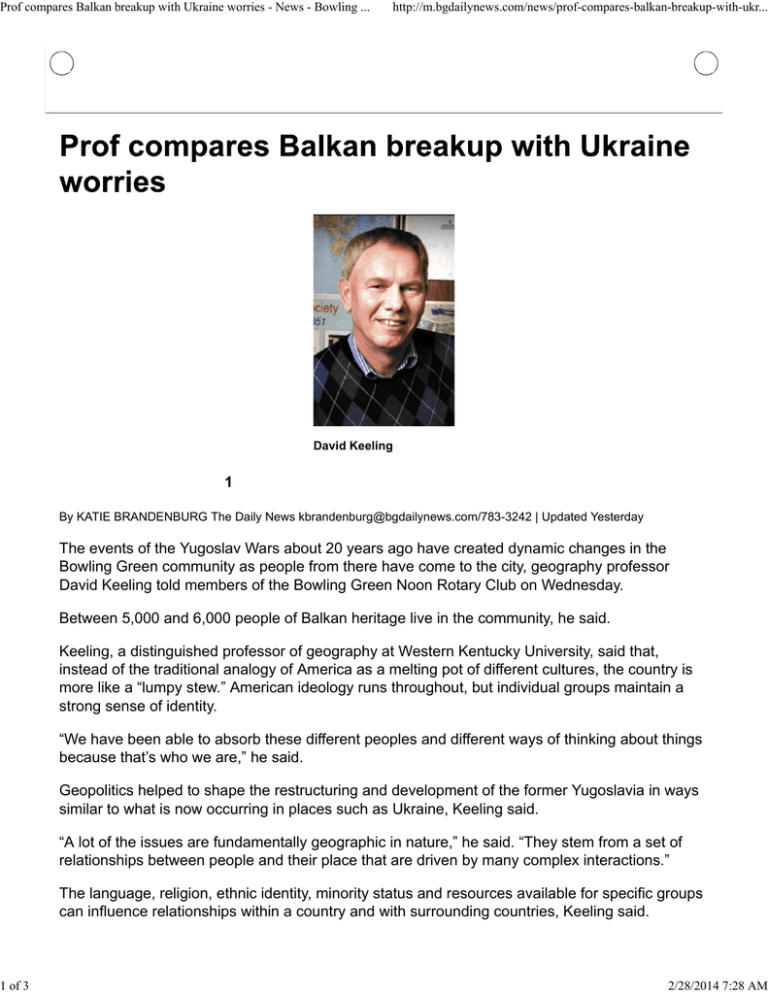Prof compares Balkan breakup with Ukraine worries - News -...
advertisement

Prof compares Balkan breakup with Ukraine worries - News - Bowling ... 1 of 3 http://m.bgdailynews.com/news/prof-compares-balkan-breakup-with-ukr... David Keeling 1 By KATIE BRANDENBURG The Daily News kbrandenburg@bgdailynews.com/783-3242 | Updated Yesterday The events of the Yugoslav Wars about 20 years ago have created dynamic changes in the Bowling Green community as people from there have come to the city, geography professor David Keeling told members of the Bowling Green Noon Rotary Club on Wednesday. Between 5,000 and 6,000 people of Balkan heritage live in the community, he said. Keeling, a distinguished professor of geography at Western Kentucky University, said that, instead of the traditional analogy of America as a melting pot of different cultures, the country is more like a “lumpy stew.” American ideology runs throughout, but individual groups maintain a strong sense of identity. “We have been able to absorb these different peoples and different ways of thinking about things because that’s who we are,” he said. Geopolitics helped to shape the restructuring and development of the former Yugoslavia in ways similar to what is now occurring in places such as Ukraine, Keeling said. “A lot of the issues are fundamentally geographic in nature,” he said. “They stem from a set of relationships between people and their place that are driven by many complex interactions.” The language, religion, ethnic identity, minority status and resources available for specific groups can influence relationships within a country and with surrounding countries, Keeling said. 2/28/2014 7:28 AM Prof compares Balkan breakup with Ukraine worries - News - Bowling ... 2 of 3 http://m.bgdailynews.com/news/prof-compares-balkan-breakup-with-ukr... Because of that, it will be interesting to see how Russia reacts to unrest in the country, he said. The region of the former Yugoslavia is very diverse in terms of ethnicity, language and religion, Keeling said. “It’s not an easy region to understand in terms of overlapping identities,” he said. There are a number of areas in the region where there is no set majority, Keeling said. Slovenia was the first part of Yugoslavia to break away and was among the most homogenous places within the region, he said. The death of Marshal Josip Broz Tito, the Yugoslavian president, in 1980 created a power vacuum and an economic crisis in the country, Keeling said. In 1986, Slobodan Milosevic stepped in to take some of that power, he said. Milosevic was a Serbian nationalist whose philosophy was to go into areas where Serbs lived, purge the territory of non-Serbians and take over. “As in many situations that we’ve seen around the world, it only takes one despot or dictator or crazy guy to send a country down a path that is not where you really want to go,” Keeling said. The collapse of the Soviet Union intensified the situation, and Yugoslavia broke down into a struggle for territory and identity, he said. Now, many of the countries within Yugoslavia have been working to build systems that will help them integrate into the European Union, Keeling said. Some people believe Ukraine could split into two parts or disintegrate in the way that Yugoslavia did, Keeling said. The western part of the country is more European, while the eastern part of the country is largely Russian. However, Ukraine does not have the same identifiable groups within the country that Yugoslavia did, which could make breaking into different states more complicated, Keeling said. — Follow government beat writer Katie Brandenburg on Twitter at twitter.com/BGDNgovtbeat or visit bgdailynews.com. We Recommend 2/28/2014 7:28 AM




